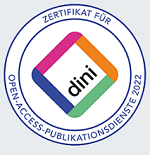Eldorado - Repository of the TU Dortmund
Resources for and from Research, Teaching and Studying
This is the institutional repository of the TU Dortmund. Ressources for Research, Study and Teaching are archived and made publicly available.

Communities in Eldorado
Select a community to browse its collections.
Recent Submissions
A time-adaptive finite element phase-field model suitable for rate-independent fracture mechanics
(2024-08-01) Rörentrop, Felix; Boddin, Samira; Knees, Dorothee; Mosler, Jörn
The modeling of cracks is an important topic — both in engineering as well as in mathematics. Since crack propagation is characterized by a free boundary value problem (the geometry of the crack is not known beforehand, but part of the solution), approximations of the underlying sharp-interface problem based on phase-field models are often considered. Focusing on a rate-independent setting, these models are defined by a unidirectional gradient-flow of an energy functional. Since this energy functional is non-convex, the evolution of the variables such as the displacement field and the phase-field variable might be discontinuous in time leading to so-called brutal crack growth. For this reason, solution concepts have to be carefully chosen in order to predict discontinuities that are physically reasonable. One such concept is that of Balanced Viscosity solutions (BV solutions). This concept predicts physically sound energy trajectories that do not jump across energy barriers. The paper deals with a time-adaptive finite element phase-field model for rate-independent fracture which converges to BV solutions. The model is motivated by constraining the pseudo-velocity of the crack tip. The resulting constrained minimization problem is solved by the augmented Lagrangian method. Numerical examples highlight the predictive capabilities of the model and furthermore show the efficiency and the robustness of the final algorithm.
Bicontinuous oxide heterostructures based on mixed zinc oxide/tin dioxide film for high photoconductivity
(2024-08-09) Al-Bataineh, Qais M.; Ahmad, Ahmad A.; Alakhras, Lina A.; Alebrahim, Mohammad A.; Telfah, Ahmad
Here, a bicontinuous oxide heterostructure film based on zinc oxide (ZnO) and tin dioxide (SnO2) is proposed for effiecient photodetection applications. XRF reveals that mixed ZnO/SnO2 film contains about equal element percentages of Zn (43.8 %) and Sn (41.7 %). XRD and SEM confirm the superior crystallinity of the heterostructure of the mixed ZnO/SnO2 film. The bandgap energies of ZnO and SnO2 films are calculated to be 3.17 eV and 3.31 eV. On the other hand, the mixed ZnO/SnO2 heterostructure film has a lower bandgap energy of 2.92 eV, which can be attributed to the fact that the heterostructure can generate the electron from the valence band of SnO2, and the holes could assemble at the conduction band of ZnO. The photoresponsivity of mixed ZnO/SnO2 film is higher than that of pure ZnO and pure SnO2 films. Additionally, the current of mixed ZnO/SnO2 film as a function of time exhibits good consistency and repeatability with rectangular profiles. It can be concluded that mixed ZnO/SnO2 film is considered a potential candidate for photodetector devices.
Bayesian optimization of gray-box process models using a modified upper confidence bound acquisition function
(2024-12-19) Winz, Joschka; Fromme, Florian; Engell, Sebastian
Optimizing complex process models can be challenging due to the computation time required to solve the model equations. A popular technique is to replace difficult-to-evaluate submodels with surrogate models, creating a gray-box process model. Bayesian optimization (BO) is effective for global optimization with minimal function evaluations. However, existing extensions of BO to gray-box models rely on Monte Carlo (MC) sampling, which requires preselecting the number of MC samples, adding complexity. In this paper, we present a novel BO approach for gray-box process models that uses sensitivities instead of MC and can be used to exploit decoupled problems, where multiple submodels can be evaluated independently. The new approach is successfully applied to six benchmark test problems and to a realistic chemical process design problem. It is shown that the proposed methodology is more efficient than other methods and that exploiting the decoupled case additionally reduces the number of required submodel evaluations.
Scientific Disciplines
(2025) Kreutzer, Tobias
Despite a tendency to proclaim new paths to interdisciplinary and transdisciplinary knowledge production—both in academia and in science policy—scientific disciplines still constitute the core of academic identities, research practices, and organizational structures. This article provides an overview of the origins and dimensions of scientific disciplines, and highlights dimensions of disciplinarity relevant to science studies and science communication.
Living Handbook of Science Communication and Science Studies
(2024-12-11) Griem, Julika; Kaldewey, David; Ruf, Oliver; Siess, Andreas; Wormer, Holger
